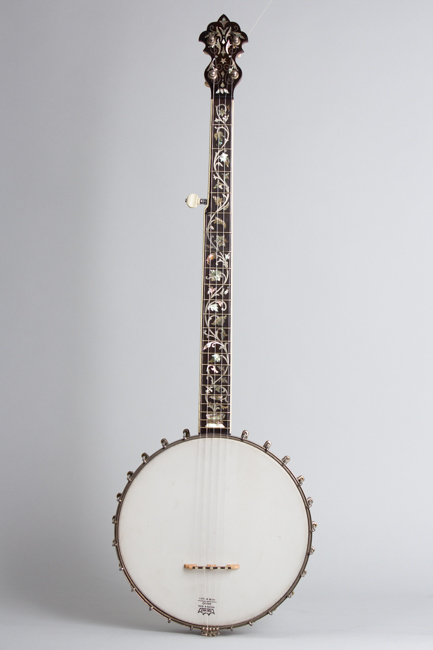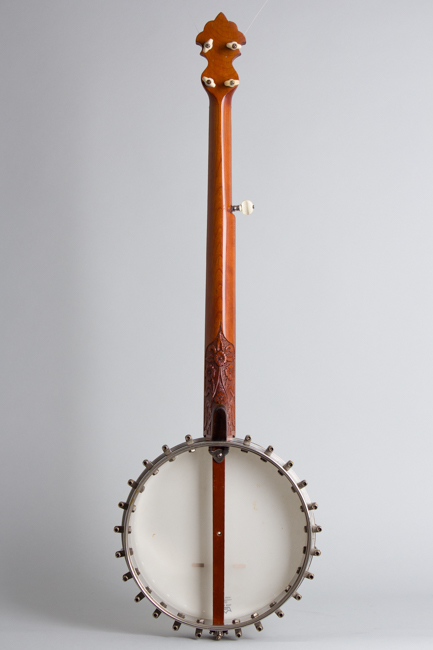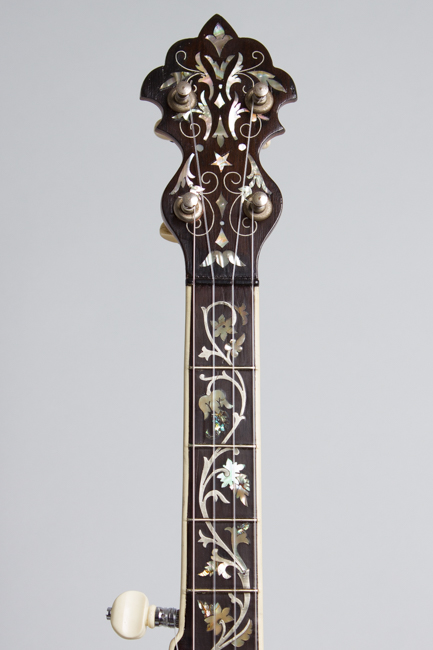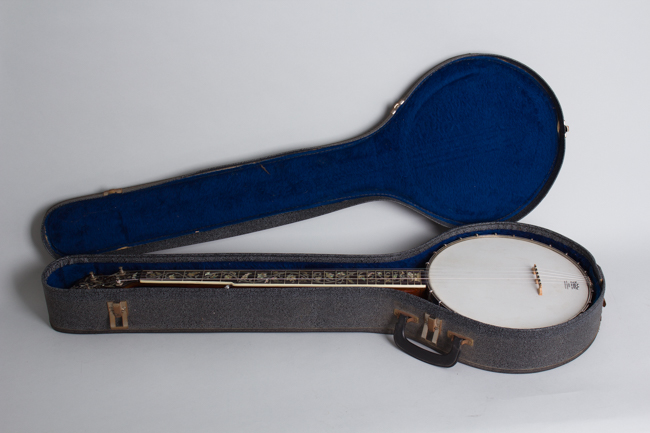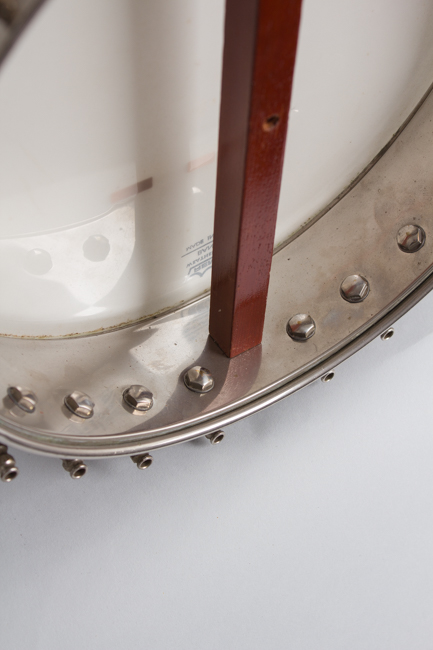Unlabelled 5 String Banjo, most likely made by S. S. Stewart , c. 1900
Unlabelled Model 5 String Banjo, most likely made by S. S. Stewart, c. 1900, made in Philadelphia, PA, natural finish, double spun rin, cherry neck with ebonized fingerboard, black chipboard case.
Often with "Catalog Jobber" instruments we can tell you who sold it but not who built it; in this case it's the opposite; we know who most likely made this lovely banjo but as it carries no markings at all not who they made it for! It was almost certainly built by the S.S. Stewart company of Philadelphia for sale by some other concern, like Sears, Roebuck & Co. or another similar retailer or jobber. While not branded it is a fairly fancy example of the sort of "Catalog" instruments sold all over the US around 1900. Some features of this banjo suggest a build date right around the turn of the 19th-20th century, sometime after Stewart himself died but his company was still in operation.
The elaborate headstock is typically Stewart style, as is the neatly carved floral-pattern heel. The inlay work is quite impressive, a fingerboard-long floral vine pattern executed in pearl, abalone and silver (or pewter) wire. The delicately inlaid headstock is also a very neat piece of work. The fingerboard is underlaid with several colored wood veneers, as is the heelcap and headstock face. The thick white composite fingerboard binding is unusual for a Stewart build but appears original; if it was added, it was a LONG time ago. The rim is double-spun inside and out, which is also somewhat unusual for a Stewart instrument. While perhaps a bit of a mystery this is a high-grade and lovely end-of-the-19th-century banjo, a beautiful survivor of the age.
Overall length is 36 in. (91.4 cm.), 10 7/8 in. (27.6 cm.) diameter head, and 2 1/2 in. (6.4 cm.) in depth, measured at side of rim. Scale length is 26 1/2 in. (673 mm.). Width of nut is 1 1/4 in. (32 mm.).
This is a nicely preserved banjo overall, and quite a good player within its period limits. Nearly all the hardware appears original including a complete set of hooks and nuts, Champion tuners and Elite tailpiece. The 5th string peg is later, as is of course the plastic head and the bridge. There is not much wear overall considering this banjo is at least 120 years old, some general wear to the finish and plating and dings and dents to the rim and hoop.
The elaborate pearl-and-wire inlay is all perfectly preserved, the ebonized heelcap shows one tiny shallow split. At some point someone drilled a hole in the dowel for a plate resonator, but that could be easily filled if desired. As with most Stewart banjos the neck is not perfectly straight, but quite suitable for the NylGut strings fitted. It has been noticeably shimmed to achieve a good playing action but is very solid. This is a lovely instrument, a very good player's 19th century style banjo and quite a showpiece for 19th century style fancy inlay work. Excellent - Condition.
Often with "Catalog Jobber" instruments we can tell you who sold it but not who built it; in this case it's the opposite; we know who most likely made this lovely banjo but as it carries no markings at all not who they made it for! It was almost certainly built by the S.S. Stewart company of Philadelphia for sale by some other concern, like Sears, Roebuck & Co. or another similar retailer or jobber. While not branded it is a fairly fancy example of the sort of "Catalog" instruments sold all over the US around 1900. Some features of this banjo suggest a build date right around the turn of the 19th-20th century, sometime after Stewart himself died but his company was still in operation.
The elaborate headstock is typically Stewart style, as is the neatly carved floral-pattern heel. The inlay work is quite impressive, a fingerboard-long floral vine pattern executed in pearl, abalone and silver (or pewter) wire. The delicately inlaid headstock is also a very neat piece of work. The fingerboard is underlaid with several colored wood veneers, as is the heelcap and headstock face. The thick white composite fingerboard binding is unusual for a Stewart build but appears original; if it was added, it was a LONG time ago. The rim is double-spun inside and out, which is also somewhat unusual for a Stewart instrument. While perhaps a bit of a mystery this is a high-grade and lovely end-of-the-19th-century banjo, a beautiful survivor of the age.
Overall length is 36 in. (91.4 cm.), 10 7/8 in. (27.6 cm.) diameter head, and 2 1/2 in. (6.4 cm.) in depth, measured at side of rim. Scale length is 26 1/2 in. (673 mm.). Width of nut is 1 1/4 in. (32 mm.).
This is a nicely preserved banjo overall, and quite a good player within its period limits. Nearly all the hardware appears original including a complete set of hooks and nuts, Champion tuners and Elite tailpiece. The 5th string peg is later, as is of course the plastic head and the bridge. There is not much wear overall considering this banjo is at least 120 years old, some general wear to the finish and plating and dings and dents to the rim and hoop.
The elaborate pearl-and-wire inlay is all perfectly preserved, the ebonized heelcap shows one tiny shallow split. At some point someone drilled a hole in the dowel for a plate resonator, but that could be easily filled if desired. As with most Stewart banjos the neck is not perfectly straight, but quite suitable for the NylGut strings fitted. It has been noticeably shimmed to achieve a good playing action but is very solid. This is a lovely instrument, a very good player's 19th century style banjo and quite a showpiece for 19th century style fancy inlay work. Excellent - Condition.
